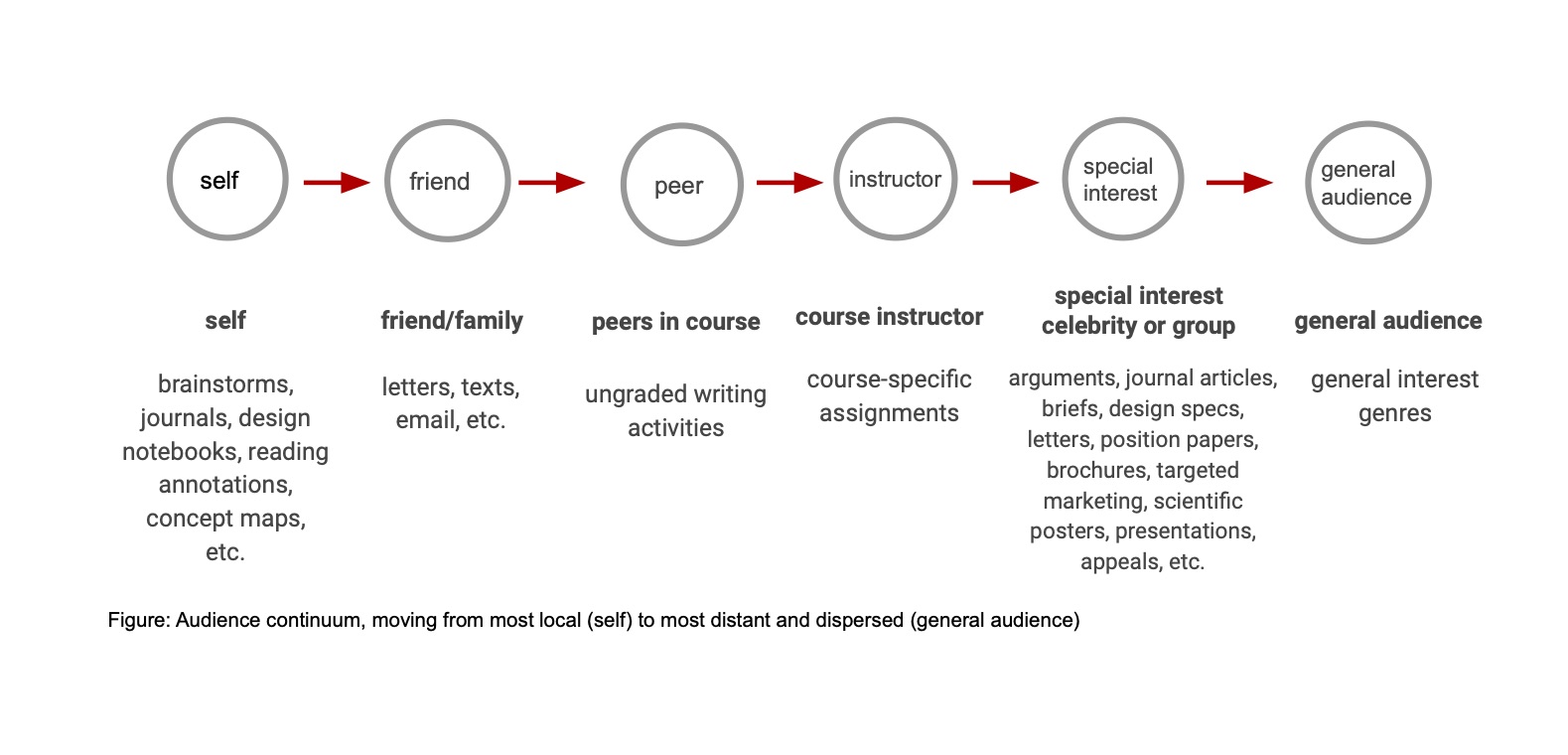
Grammar Matters
Colleagues from across academic disciplines ask about strategies they can use to address problems related to grammar, usage, style, and mechanics in student writing. On this page, we begin by considering pragmatic goals before listing strategies that allow instructors from across the curriculum to address sentence-level issues within diverse course and disciplinary contexts.
- What’s the point?
- Clarify grammar-related expectations in assignments and grading criteria
- Offer timely, specific, and assignment-relevant grammar instruction
- Address sentence-level issues with comments
- Additional tips
What's the point?
Reading through sentence-level errors can be distracting. We may feel strongly tempted to correct each error as we move down the page—a practice that few of us have adequate time to undertake. It can be helpful to remember, therefore, that when we approach student writing as educators—rather than as professional editors—our pedagogical goal is to help these writers gain control over their own ideas and writing. Effective writers feel capable of making intentional and context-relevant grammatical, stylistic, and mechanical choices, choices that will result in their texts’ having desired impacts on readers. Ultimately, we hope that our assignments, comments, and grades can help students develop enough familiarity with a variety of writing situations and standards to enable them to make wise choices about where and when they want to conform to—and when they want to stretch or challenge—grammatical conventions.
Clarify grammar-related expectations in assignments and grading criteria
Expectations related to written style, tone, and grammar standards are helpfully conveyed in the assignment itself, both in its description of the writing and thinking problem students are asked to solve and in its provision of grading criteria that will be used to assess the result. Here are some examples of descriptive criteria used to assess grammar, usage, and mechanics.
- Uses language that skillfully and consistently communicates meaning to readers and contains few if any distracting errors.
- Conveys meaning precisely using unambiguous language and logic.
- Conforms to stylistic conventions appropriate to lab reports (as outlined in the assignment).
- Sentence structure and word choice are uniformly lucid, and paragraphing is logical and fluid.
The relative weights assigned to grammar-related criteria merit careful consideration. Consider, for example, that assigning the same weight to grammatical correctness as you assign to quality of analysis might cause students to take fewer risks with the ideas they’re developing in their texts. Some instructors choose to forgo the inclusion of discrete grammar-related grading criteria knowing that grammar use is included in other criteria. The successful communication of analysis, the accurate portrayal of experimental methods, the logic used in presenting an argument, etc., are all impacted by attention to grammar, style, and mechanics.
Design assignments that designate a target audience. A writer’s attention to grammar and style is informed by their conception of the audience they’re writing to and their reason for writing. While it’s not unreasonable to ask students to become familiar enough with a set of grammar standards to be able to use them, we know that this attention to correctness is not appropriate in every writing situation students encounter. To strengthen students’ ability to make nimble and aligned writing choices, instructors can designate target readers as an element of their writing assignments. When doing so, they’ll need to grade the writing students do according to its address of the designated audience. The figure below maps categories of audience that can be designated in writing assignments.
Offer timely, specific, and assignment-relevant grammar instruction
Research has long indicated that explicit instruction in grammar and usage, when conducted outside the context of a specific writing activity or assignment, is typically unproductive and may even prove to be counterproductive (Braddock et al 1962, Hillocks 1980, Sommers 1982, Weaver 1996). Instead, productive instruction occurs as students writers are drafting and revising. The strategies we offer below are designed to align with course goals, assignment design, and writing assessment.
Provide opportunities for focused, low-stakes practice:
Use five-minute revision workshops when you’ve detected patterns of writing problems in a critical mass of student work. Doing so can enable you (and course TAs) to avoid spending time repeating similar comments on multiple students’ drafts. It can also help students to become more effective proofreaders and revisers.
Organize peer response activities. Although most peer response guidelines ask students to focus on higher-order issues, it may be appropriate to ask them to comment on any patterns of meaning-interfering errors they detect. Doing so can benefit both parties, as commenters may detect writing problems that also apply to their own work.
Build revision into your assignments so that students can act on feedback rather than understanding it merely as a justification for a grade. Without opportunities to review, error-oriented feedback will have little effect on subsequent performance.
Assign revision memos to heighten students’ awareness of their writing strengths and weaknesses and of revision strategies they employ to remedy problems.
Address sentence-level issues with comments
First, read to understand. Research indicates that when novice teachers of writing approach student work, they typically read to find fault, mix comments about big and small-picture issues, and suggest specific stylistic revisions. Experienced teachers of writing, on the other hand, read first to understand student thinking, comment on patterns of strength and weakness, and emphasize suggestions for major reorganization and expansion (Walvoord and Smith 1982; Palmquist and Young 1992).
Praise success. We academics pride ourselves on the ability to read critically and name flaws. As writers by both profession and habit, however, we’re also likely to recognize the power that genuine praise has had in helping us to develop fluent writing abilities. Describing the positive impact of particularly successful word choices, phrasing, or sentence construction can provide students with instructive affirmation of their textual choices and position them to leverage this success as they make future wording and construction choices elsewhere.
Prioritize. Top priority errors are likely those that honestly impede reader comprehension, those that are copiously repeated throughout a draft, and those that are closely connected to the primary objectives of the assignment. Informing students about what you were looking for and commenting upon (and what you may not have commented upon) can relieve you of the sense that you must comment on every grammatical problem you see.
Resist copyediting, start diagnosing. When commenting on revisable drafts, it can be difficult to resist the impulse to copyedit or comment upon every detected gaffe. It's important to recognize, however, that this exhausting practice typically works against the goal of helping students become effective revisers of their own work. Thus, to help students learn to detect, diagnose, and remedy revisable issues in their own writing, consider taking a mental step back before digging in to untangle and decipher problematic constructions. Ask yourself, “What’s going on here?” Diagnosing underlying causes of errors allows you to align comments appropriately. Here are five examples of this sort of diagnosis:
- A writer’s in-process thinking is resulting in garbled expression.
When students—or any of us—write about new and complicated ideas in unfamiliar ways under tight time deadlines, we can end up communicating our mental-verbal struggle rather than our brilliant and well-formed ideas.
Useful comments: In these cases it can be useful to respond to unclear passages as a reader rather than a grammarian by jotting down what the passage forces you to wonder (e.g.: “I’m not following you here” or "As I read this, I think you are saying ___. Do you mean something else?” or “Your final paragraph states your argument with a clarity that I missed earlier on. As you revise, consider moving that paragraph up and developing from there.”) In-process thinking can also impede a draft’s flow, in which case you might refer writers to references related to organization and coherence. These comments may give students enough information (and perspective) to address the problem. A conversation during your office hours, a meeting with a course TA, or an appointment with Student Writing Support (SWS) consultants can also be useful in helping students to clarify their thinking and writing.
- A writer’s lack of familiarity with expected English grammar structures or, in the case of multilingual writers, the unintentional intervention of another language, is resulting in repeated patterns of grammatical errors (e.g., article use, tense problems, atypical word sequencing).
Useful comments: Research shows that making direct corrections (copyediting) for students rarely results in helping student writers eliminate future repetitions of those errors. Instead, consistent patterns of grammatical issues can be helpfully described and matched with resources. If you’re able to diagnose the issue, do so: “I’m seeing a pattern of verb tense issues throughout the literature review sections of this draft. This subject-verb agreement resource may help you revise.” Alternatively, placing a checkmark or other pre-defined symbol in the margin by a problematically unclear passage can signal to students that they need to take a closer look and consider rephrasing. For more on this approach, see Minimal Marking.
- A writer’s lack of familiarity with usage conventions governing the forms of academic discourse that you’ve assigned results in problems with organization, tone, style, and source use.
Useful comments: Referring students back to your assignment and/or providing them with a rationale for expected disciplinary conventions may be all that’s needed. You might also provide direct links to particular resources such as usage manuals, quick references related to figures and tables, paraphrasing versus direct quotes (and unintentional plagiarism).
- A writer’s intentional choices differ from those you expected or prefer.
Useful comments: In some cases, it can be useful to consider whether the writing we’re reviewing is seriously flawed or is simply out of accord with a personal style preference. Provide authentic reader-based reactions, e.g., “This wasn’t what I was expecting. Here’s what I wonder….” or “I’m having trouble following you here...do you mean ___?” In assignments that require students to address a different reader, you might comment with questions like, “How do you hope your target readers will react to this phrasing?” or “How is this phrasing going to work toward your goal of neutral description?”
- A missed opportunity for proofreading results in grammar errors, typos, spelling issues and punctuation problems.
Useful comments: Describing the impact these distracting elements have on your ability to understand what it is that a writer is trying to convey can be constructive to more careful proofing practices. “My ability to follow you here is hampered by frequent typos.” If you communicate to students that their ideas are too important to be unclearly transmitted, they might be more willing to take a closer look. For students seeking proofreading strategies, here are two useful resources: Encouraging effective proofreading; Reading Aloud (University of North Carolina at Chapel Hill).
Timing matters. Grammar-focused comments made on final, graded drafts are unlikely to inspire future revisions unless we make a deliberate comment connecting the current and future assignment (e.g., “In next month’s literature review assignment, it will be important for you to address the issue of consistency in verb tenses I’m seeing in this draft. Let me know if you have questions.”).
Additional tips
- Student-facing resources: Student Writing Support Quick Help
- Is Grammar Correction Worth the Effort? Strategies for Written Corrective Feedback
- Dealing with sentence-level errors: The value of distinguishing error types


